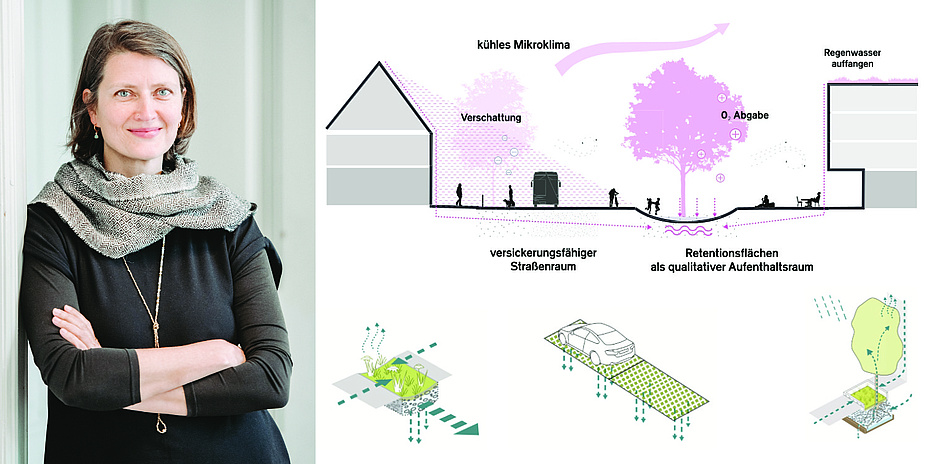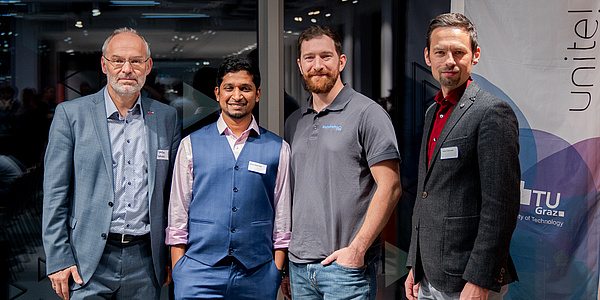The City as a Sponge - Turning Heat Islands into Water Reservoirs

Despite all the initiatives and debates, land use in Austria continues to rise almost constantly. Last year it was twelve hectares - per day. Almost half of this was sealed, i.e. built over, tarmacked or paved. This corresponds to eight football fields, which can heat up to 50 degrees Celsius in summer and where rain cannot seep into the ground. Such sealed surfaces lead to heat islands and increase the risk of flooding during heavy rainfall.
In the inner cities, almost every square metre is used, which is why newly sealed areas are added mainly on the outskirts, in the so-called peri-urban space: "The defining element here is the transport infrastructure, i.e. roads and car parks. Everything else is established around it," says Eva Schwab from the Institute Institute of Urbanism at Graz University of Technology. Often these are commercial areas and DIY stores, and too little thought is given to green spaces and water bodies. As a result, peri-urban spaces are often fragmented and inhospitable in their functional mix of large-scale commercial, residential and transport infrastructure.
Influencing factors: topography, soil properties and contaminations
Yet urban and peri-urban spaces can also be designed differently - with minimal sealing and sufficient areas where bushes and trees provide shade. At suitable locations, pits are created where rainwater can accumulate and seep into the ground. In this way, the urban space can absorb more water and slowly return it to the surroundings via the vegetation - like a sponge. The principle has been known for some time, but like so often, but implematation can be trixcky. The sponge city concept has to be adapted to local conditions," says Eva Schwab. Important factors include the topography, groundwater level, soil conditions and possible contamination. "For example, if the substrate is waterlogged, an percolation site is not an option," says Schwab. In such a case, however, a small pond might be suitable as an alternative, which can cool the surrounding area in summer through evaporation. Or the rainwater could be diverted to another location where it can seep into the ground.
In the PeriSponge project, in which the Institute of Urban Water Management and Landscape Water Engineering at Graz University of Technology is also involved, Eva Schwab is investigating how these concepts can be implemented in reality. PeriSponge is working with the cities of Feldbach, Wels and Feldkirchen and is developing tailor-made green-blue, i.e. vegetation- and water-related measures in each case. Numerous experts were recruited for the project consortium in order to guarantee the necessary integral approach in planning and design. The planners from Verkehrplus provide important current traffic data, on the basis of which, for example, road widths can be reconsidered. bgmr landscape architects from Berlin developed the design concept for the pilot project in Feldbach, in which Grün statt Grau is also involved with know-how on greening buildings. Maria Baumgartner, a landscape planner from Graz, contributes her many years of experience in participation processes to the communication with the citizens of Feldbach.
Seven interventions in Feldbach
In preliminary studies, neuralgic points were found in Feldbach, Wels and Feldkirchen where sewers frequently overflow, or heat accumulation occurs. Together with politicians, administrators, but also local residents and businesses, the researchers then discussed green-blue measures that can best mitigate or even eliminate the local problems. In Feldbach, for example, a total of seven intervention are being implemented on a 300-metre section of a road: individual buildings are being disconnected from the sewer system so that the rainwater seeps into the ground on the property; the width of the road is being reduced to make room for green strips; parking spaces will get permeable surfaces; and at the cemetery, some parking spaces are being eliminated so that trees can be planted.
When the construction and planting work is completed, in the final year of the project Schwab's team will measure in detail how the microclimate has changed, how much water now seeps into the ground, but also whether the green spaces and the footpaths and cycle paths are frequented more often than before.
Building on the results from Feldbach, Wels and Feldkirchen, Schwab wants to create a toolbox that other municipalities can use when they want to implement green-blue measures. On the one hand, these tools include information on the (landscape) physical measures, how they are to be technically implemented, for which locations they are suitable and what effects they have. "On the other hand, our toolbox refers to project management," says Eva Schwab, "How should a municipality approach such a process? Who should it involve? What are critical moments in communication?" Within the framework of PeriSponge, an ideal-typical procedure will be developed.
There is certainly demand for this systematic planning toolbox in many municipalities in Austria and beyond. "Because water," says Eva Schwab, "is not something that has to be diverted away as quickly as possible. We have to keep it in the city in an intelligent way to be able to use it: against the heat and for more quality of life."
Would you like to receive the latest stories, news, research stories, interviews or blog posts from TU Graz directly on your smartphone or in your email inbox? Subscribe to the TU Graz Telegram newsletter free of charge.
Kontakt
Eva SCHWAB
Dipl.-Ing. Dr.nat.techn.
TU Graz | Institute of Urbanism
Phone: +43 316 873 6282
eva.schwab@tugraz.at




